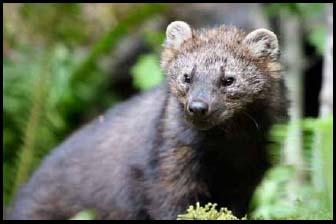Completion of an environmental assessment into the question of returning fishers to Olympic National Park has cleared the way for a recovery program to begin, possibly before year's end.
The EA concluded that helping the cat-sized carnivores return to the Olympic Peninsula would have no significant impact.
“With completion of the environmental analysis, we are eager to move forward with restoring a missing piece of the Olympic forest,” says Olympic Superintendent Bill Laitner. “If all goes well, we hope to release fishers into the park this fall or winter.”
The Fisher Reintroduction Plan Environmental Assessment (EA), developed in partnership with the Washington Department of Fish and Wildlife with collaboration by the Olympic National Forest was released for a 30-day public comment period this September. Nearly 200 public comments were received by the park and considered in development of the Finding Of No Significant Impact.
The EA analyzed three alternatives, including a no action alternative. The selected alternative, Alternative B in the EA, calls for fishers to be captured from a source population in western Canada and reintroduced into Olympic National Park in three areas: the Elwha-Sol Duc, the Hoh-Bogachiel, and the Queets-Quinault areas. Under the proposal, a founder population of at least 100 fishers will be released over a three-year period.
Fishers are small, reclusive hunters and are related to mink, otter and marten. Fishers are native to the forests of Washington, including the Olympic Peninsula, but vanished from the state because of over-trapping in the late 1800s and early 1900s and habitat loss and fragmentation.
“Reintroducing fishers to the forests of Olympic National Park will bring back a native species and restore a natural balance between predators and prey,” says Superintendent Laitner.
A program to monitor the success of the reintroduced fisher population has been selected as eligible for matching funds through the National Park Service Centennial Initiative. Although the Centennial Initiative still awaits congressional approval, two partner groups, Conservation Northwest and the Washington’s National Park Fund have both pledged monetary support for this project.


 Support Essential Coverage of Essential Places
Support Essential Coverage of Essential Places







Add comment